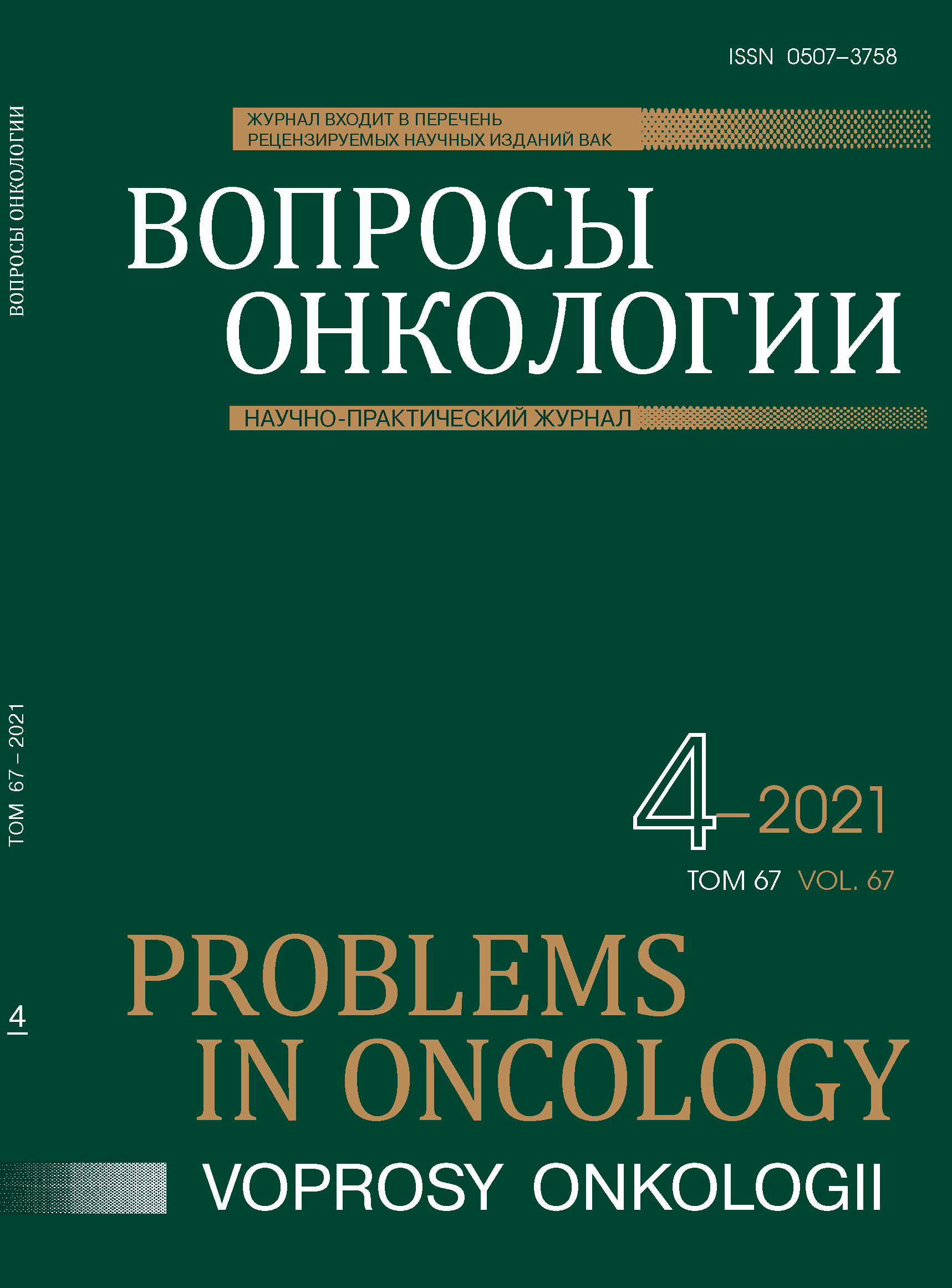Аннотация
Рецидивы серозных пограничных опухолей (СПОЯ) встречаются достаточно редко, и, вследствие этого, недостаточно изучены и представлены в литературе. Несмотря на очевидную относительную «доброкачественность» пограничных опухолей, течение и прогноз рецидивов СПОЯ может оказаться неблагоприятным. В статье изложены причины, влияющие на развитие рецидива СПОЯ, представлены различные варианты рецидивирования СПОЯ, методы их лечения. В данной публикации освещены факторы, влияющие на эффективность лечения, продолжительность жизни и прогноз заболевания. Статья иллюстрирована редким клиническим наблюдением многократного рецидивирования СПОЯ с благоприятным исходом.
Библиографические ссылки
Taylor HC. Malignant and semimalignant tumors of the ovary // Surg. Gynecol. Obstet. 1929;48:204–230.
Kurman RJ, Сarcanqiu ML, Herrington CS, Young RH. WHO Classificaihion of Tumours of Female Reproductive Organs. Fourth Edition. IARS: Lyon, 2014.
Lodhi S, Najam S, Pervez S. DNA ploidy analysis of borderline epithelial ovarian tumours // J. Pak. Med. Assoc. 2000;50(10):349–351.
Scully R.E, Young RH, Clement PB. Tumor like lesions. Tumors of the overy and maldeveloped gonads, fallopian tube and broad ligament. Washington: Armed Forces Institute of Pathology, 1998:443–444.
Shih IeM, R.J. Kurman RJ. Molecular pathogenesis of ovarian borderline tumors: new insights and old challenges // Clin. Cancer Res. 2005;11(20):7273–7279.
Shim SH, Kim SN, Jung PS et al. Impact of surgical staging on prognosis in patients with borderline ovarian tumours: a meta-analysis // Eur. J. Cancer. 2016;54:84–95.
Acs G. Serous and mucinous borderline (low malignant potential) tumors of the ovary // Am J Clin Pathol. 2005;123(Suppl.):13–57.
Lenhard MS, Mitterer S, Kümper C. Long-term follow-up after ovarian borderline tumor: relapse and survival in a large patient cohort // Eur J Obstet Gynecol Reprod Biol. 2009;145:189–94. https: // doi: 10.1016/j.ejogrb.2009.04.031 PMID: 19477060
Lalwani N, Shanbhogue AK, Vikram R. Current update on borderline ovarian neoplasms AJR // Am J Roentgenol. 2010;194(2):330–6. https: // doi: 10.2214/AJR.09.3936 PMID: 20093592
Seidman JD, Horkayne-Szakaly I, Haiba M. The histologic type and stage distribution of ovarian carcinomas of surface epithelial origin // Int J Gynecol Pathol. 2004;23:41–44. https: // doi: 10.1097/01.pgp.0000101080.35393.16
Sherman ME, Mink PJ, Curtis R. Survival among women with borderline ovarian tumors and ovarian carcinoma: a population-based analysis // Cancer. 2004;100:1045–52. https: // doi: 10.1002/cncr.20080 PMID: 14983501
Ayhan A, Akarin R, Develioglu O et al. Borderline epithelial ovarian tumors // Aust. N.Z.J. Obstet. Gynecol. 1991;31(2):174–176.
Goldman TL, Chalas E, Chumas J et al. Management of borderline tumors of the ovary // South. Med. J. 1993;86(4):423–425.
Jimenez AM, Miralles Pi RM, Sanchez AE et al. Ovarian tumors of low malignant potential (borderline). A retrospective study of 31 cases // Eur. J. Gynaec. Oncol. 1994;15(4):300–304.
Jones MB. Borderline ovarian tumors: current concepts for prognostic factors and clinical management // Clin Obstet Gynecol. 2006;49(3):517–25. https: // doi: 10.1097/00003081-200609000-00011 PMID: 16885658
Lalwani N, Shanbhogue AK, Vikram R. Current update on borderline ovarian neoplasms // AJR Am J Roentgenol. 2010;194(2):330–6. https: // doi: 10.2214/AJR.09.3936 PMID: 20093592
Bostwick DG, Tazelaar HD, Ballon SC. Ovarian epithelial tumors of borderline malignancy: a clinical and pathologic study of 109 cases // Cancer. 1983;58:2052–64 PMID: 3756820
Leake JF, Currie JL, Rosenshein NB. Long-term follow-up of serous ovarian tumors of low malignant potential // Gynecol Oncol. 1992;47:150–8. https: // doi: 10.1016/0090-8258(92)90099-5 PMID: 1468692
Riman T, Dickman PW, Nilsson S. Risk factors for epithelial borderline ovarian tumors: results of a Swedish case — control study // Gynecol Oncol. 2001;83:575–85. https: // doi: 10.1006/gyno.2001.6451 PMID: 11733975
Nikrui N (1981) Survey of clinical behavior of patients with borderline tumors of the ovary // Gynecol Oncol. 1981;12:107–19. https: // doi: 10.1016/0090-8258(81)90102-5 PMID: 6268484
Ortiz BH, Ailawadi M, Colitti C et al. Second primary or recurrence? Comparative patterns of p53 and K-ras mutations suggest that serous borderline ovarian tumors and subsequent serous carcinomas are unrelated tumors // Cancer Res. 2001;61(19):7264–7267.
Du Bois A, Ewald-Riegler N, du Bois O, Harter P. Borderline tumors of the ovary — a systematic review // Geburtsh. Frauenheilk. 2009;69:807–833.
Du Bois A, Trillsch F, Mahner S et al. Management of borderline ovarian tumors // Annals of Oncology. 2016;27 (Suppl. 1):i20–i22. https: // doi: 10.1093/annonc/mdw090
Trillsch F, Mahner S, JRuetzel JD et al. Clinical management of borderline ovarian tumors // Expert Rev. Anticancer Ther. 2010;10(7):1115–1124.
Trope C, Davidson B, Paulsen T et al. Diagnosis and treatment of borderline ovarian neoplasms «thestate of the art» // Eur. J. Gynaecol. Oncol. 2009;30(5):471–482.
Crispens MA, Bodurka D, Deavers M et al. Response and survival in patients with progressive or recurrent serous ovarian tumors of low malignant potential // Obstet. Gynecol. 2002;99(1):3–10.
Давыдова И.Ю. Серозные пограничные опухоли яичников (клинико-морфологические особенности, лечение, прогноз). Дис. … д-ра мед. наук. М., 2018.

Это произведение доступно по лицензии Creative Commons «Attribution-NonCommercial-NoDerivatives» («Атрибуция — Некоммерческое использование — Без производных произведений») 4.0 Всемирная.
© АННМО «Вопросы онкологии», Copyright (c) 2021
